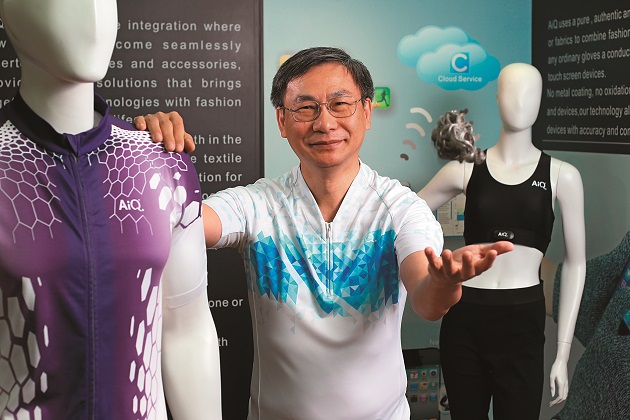High-Tech Textiles
Tex-Ray Makes Microcomputers You Can Wear

Source:CW
A specialized thread developed in Taiwan that is used as material for Intel, adidas, Lululemon and Under Armor smart clothing is the secret weapon high tech firms here are relying on to introduce new related products.
Views
Tex-Ray Makes Microcomputers You Can Wear
By Kuo-chen Lu, Elaine HuangFrom CommonWealth Magazine (vol. 570 )
According to figures from U.S.-based market research firm HIS, the global smart clothing market was worth US$586 million in 2014, a more than 30 percent rise since 2011. Bai Chi-chung, president of the Taiwan Textile Research Institute, further asserts that the production value of Taiwanese smart clothing will continue to rise steadily, making it the local textile industry's most potential-rich product.
Michael Lee, CEO and co-founder of Rooti Labs and formerly a manager at Hon Hai handset manufacturer FIH, went to AiQ Smart Clothing, a subsidiary of established textile brand Tex-Ray, to collaborate on the production of smart wearable technology.
Lee simply clips the smart NT$50 coin-sized modular biosensor his company has developed to a form-fitting workout top, and within two seconds, the top transformed into a piece of smart apparel.
"These are stainless steel threads, which begin sensing biometric data right after you put it on. It's all MIT (made in Taiwan), too," says Lee. When a runner wears this smart top during a workout, a remote person can detect where you are running and the pace. Such biometrics as heart rate can be monitored, and it can also link to smart phone apps, and conduct regular tracking to compile a personal biometric chart.
Not just Michael Lee, but even Mike Bell, vice president and general manager of new devices at Intel, was spotted last May sporting smart clothing developed with AiQ.
Upon entering Tex-Ray and AiQ's office on Linsen North Road in Taipei, we learn that Tex-Ray has been developing this fiber for over a decade. Specifically, the fiber, known as 316L, is extracted from stainless steel.
Bai Chi-chung relates that it started out as a fiber developed by a dentist in oral care. Tex-Ray threw all of its group resources into adapting it from industrial use to application in apparel.
Why did it take more than a decade to turn stainless steel into clothing? First of all, the fiber had to be over 100 times thinner than a strand of human hair, as only fiber that thin made into cloth or apparel can retain the electrical conductivity of metal whilst also being an article of clothing.
AiQ vice president Steve Huang relates that, "When you wear smart clothing made with super thin fiber, you'd never guess that it's made from metal. Yet it can sense your metrics whilst providing the softness, comfort, pliability, and washing and drying functions expected of clothing. It can also be matched with electronic devices to become a computer you wear."
In more than a decade since development commenced on smart clothing, not everything came together quickly. Huang relates that at first stainless steel fiber was used in the automobile market, and the company began investing in smart clothing development seven years ago.
The second issue involves technology and high standards. Tex-Ray was not anxious to make a profit, but rather sought to be involved in the setting of specifications by major international manufacturers and advanced countries.
Huang notes that it is like working one's way up from the mailroom to the boardroom, ensuring excellence at every level before bringing out a product.
AiQ is currently working on ISO 13485 (medical equipment quality management system) certification. Once this is achieved, products are then certified as medical grade, a challenging standard to meet.
In addition, AiQ is actively involved in related standards associations and organizations, and has joined Europe's Horizon 2020 interactive clothing electronics textile products integrated application cooperative program.
Huang Po-hsiung, director of the Department of Products, Taiwan Textile Research Institute, relates: "By participating in the EU's Horizon 2020, we can take part in specification formulation among major European countries, but that takes time and money." The good thing is that, from conductive fiber to smart clothes, AiQ can act not merely as a contract manufacturer on the supply chain, but an early stage development partner with major international brands.
Smart clothing is becoming a full-fledged industry, and AiQ of the Tex-Ray group is not Taiwan's only industry player, with other names including New Fibers Textile Corporation, Eclat, and Zentan Technology also getting into smart clothing development.
These firms are going all out, taking Taiwan's textile industry forward and combining it with Taiwan's information technology industry to develop smart clothes. Making computers and mobile phones into something we can wear like clothing is happening, right here and right now.
Translated from the Chinese by David Toman






